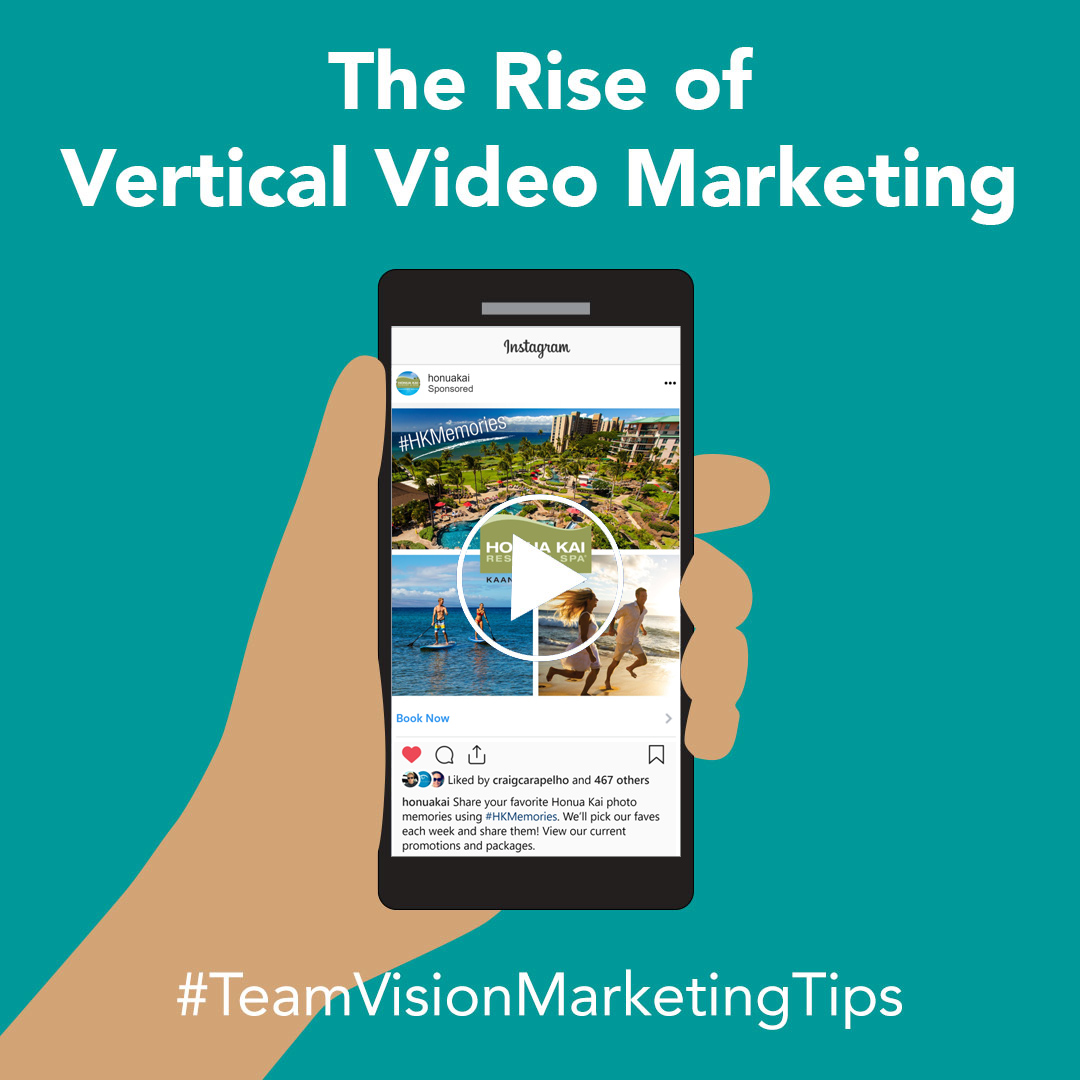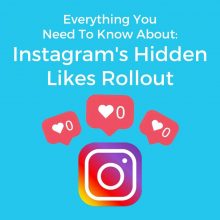The Rise of Vertical Video Marketing
2019 is the year of vertical video marketing. Social media apps, such as Instagram, Facebook, SnapChat, and Twitter, have recently embraced and fully committed to being vertical video friendly for both organic and paid social media posts. This means that businesses and marketers need to make the shift and embrace the vertical video format trend for their social media marketing strategy.
This post was created to explain why we’re moving away from horizontal videos and includes tips on shooting and editing for the new vertical format. If you need assistance with your video marketing needs, reach out to Team Vision Marketing – we would love to help you!
Not on the video marketing bandwagon, yet? Check out our recent blog post on why local Hawaii businesses need to make the shift to video marketing.
The History of Vertical Video
For as long as movie screens and TVs have been around, we have been conditioned to watch videos in a horizontal or landscape aspect. From a practical point of view, it is easier for filmmakers to film in a wider shot. This is because horizontal frames have more visual real estate and the actors could move around in a single frame, without the need for the camera to follow their every movement. The horizontal aspect ratio also mimics the width of a theater’s stage.
We started to see screens go vertical with the invention of the mobile phone. Naturally, as mobile phones became smarter over the years, so did the way we needed to present visual components. When the camera phones first came out, it encouraged more phone users to take photos and videos in the portrait or vertical aspect.
But why are we shifting to vertical? This is simply because today’s smartphones were designed to be viewed and used vertically. Therefore, phones make it seamless and easier for the consumer to view content in a vertical format (versus having to turn the phone sideways to view horizontal content).
Despite the increased number of vertical photos and videos created by mobile users, social media apps were slow to adapt to and accept the new aspect ratio. Remember, we have been conditioned to watch horizontal videos. So even in the beginning of the revolutionary iPhone era, videos could only be watched and uploaded in landscape on Facebook and YouTube.
Then, in 2015, SnapChat changed the game by allowing users to post vertical videos and view them in full screen mode without black borders or having to flip the phone to landscape orientation. SnapChat claims that vertical videos and ads are more engaging for audiences. According to SnapChat, vertical video ads have a completion rate that’s nine times higher and that capture double the audience’s visual attention than other platforms. This is because a vertical video’s thinner frame allows the customer to focus on the main subject by decreasing peripheral distractions.
Today, vertical videos are found all over social media. Instagram, Facebook, YouTube, and Twitter now provide users with the ability to advertise using full-screen vertical videos. Now, the portrait aspect ratio is the only video format that IGTV, Instagram Stories, and Facebook Stories accepts.
Vertical Video Filming Tips
There are three suggested filming options for vertical videos:
1) The best device to film vertical videos is on a high-quality smartphone camera, which has a built-in 9:16 camera aspect ratio.
2) You can film on DSLR cameras, which typically have a 2:3 aspect ratio, and digital video cameras, which usually have a 4:3 ratio, for higher quality videos. We suggest turning the camera on its side to limit your video editing efforts.
3) If you’re confident in your video editing and directing skills, you can choose to film in a horizontal aspect. However, this option is pretty difficult to do, as it requires a lot of editing and conscious framing during the shoot.
Vertical Video Friendly Social Media Apps
Instagram TV (IGTV):
Recommended Aspect Ratio |
Minimum: 4:5Maximum: 9:16 |
Video File Size |
10 minutes or less: 650 MB60 minutes: 3.6 GB |
Video Dimensions & Resolution: |
Minimum Resolution: 720 pxMinimum Frame Rate: 30 fps |
Video Length |
IGTV:15 seconds – 10 minutes on smaller accountsNote: 60 minutes on larger or verified accounts |
Accepted Video Format |
.MP4 |
Recommended Cover Photo Size |
420px x 654px (1:1.55 ratio) |
Instagram In-Feed & Stories Ads
Recommended Aspect Ratio |
In-Feed: 4:5Stories: 9:16 |
Video File Size |
Stories Maximum: 4GB |
Video Dimensions & Resolution: |
In-Feed Minimum Dimension: 600 x 750 pxStories Dimension: 1080 x 1920 pxStories Minimum Resolution: 720 px |
Video Length |
In-Feed: 3 seconds – 60 secondsStories: 10 seconds |
Accepted Video Format |
.MP4 or .MOV |
Facebook:
Recommended Aspect Ratio |
In-feed: 2:3, 4:5, 9:16Stories: 9:16 |
Video File Size |
4 GB |
Video Dimensions & Resolution: |
Recommended Dimensions: 1280 x 720 (landscape & portrait)Maximum Resolution: None |
Video Length |
Maximum: 240 minutes |
Accepted Video Format |
.MP4 or .MOV |
YouTube (Must be uploaded by desktop):
Recommended Aspect Ratio |
9:16 |
Video File Size |
Maximum 128 GB |
Video Dimensions & Resolution: |
426 x 240 (240p)640 x 360 (360p)854 x 480 (480p)1280 x 720 (720p)1920 x 1080 (1080p)2560 x 1440 (1440p)3840 x 2160 (2160p) |
Video Length |
Maximum: 12 hours |
Accepted Video Format |
.MOV, .MPEG4, MP4, .AVI, .WMV, .MPEGPS, .FLV, 3GPP, and WebM |
Snap Chat:
Recommended Aspect Ratio |
9:16 |
Video File Size |
In-Feed/Ad: 32 MBLong form: 1 GB |
Video Dimensions & Resolution: |
1080 x 1920 px |
Video Length |
In-Feed/Ad: 3 – 10 secondsLong form: 15 seconds, no max |
Accepted Video Format |
.MOV or .MP4 |
Twitter:
Recommended Aspect Ratio |
Between 1:2:39 to 2:39:1 |
Video File Size |
Maximum: 512 MB |
Video Dimensions & Resolution: |
Dimensions: 240 x 240 (256K bitrate), 480 x 480 (768K bitrate) and 640 x 640 (1024K bitrate)Maximum Video Frames: 40 fps |
Video Length |
Maximum: 140 seconds |
Accepted Video Format |
.MP4 (web) and .MOV (mobile) |








